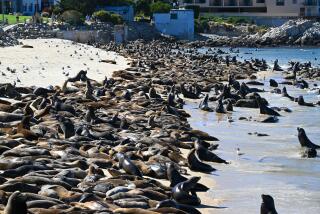Wildlife Officials’ Efforts to Capture Sea Otters Begin
- Share via
Federal and state wildlife officials went to sea Tuesday to begin a weeklong effort to capture 10 sea otters that have been bingeing on valuable abalone at San Miguel Island.
If the officials are successful in capturing the elusive and sometimes ferocious animals, wildlife experts will return them to the main California sea otter herd off the Central California coast.
Wildlife experts were unsure whether the animals strayed from the main herd or from a colony transplanted to San Nicolas Island, 60 miles off the Ventura coast. Biologists have attempted to establish the spinoff colony at San Nicolas to preserve the species in case an oil spill wiped out the main herd.
Regardless of the animals’ origins, biologists planned to return all of them to the main herd.
“If some of these errant otters at San Miguel are from San Nicolas, they may have a tendency to stray,” said David Klinger, a spokesman at the Pacific Regional office of Fish and Wildlife in Portland. “If we move them back to San Nicolas, it just sets us up for another capture program.”
The captures were expected to be difficult because of the typically rough seas and sharks off San Miguel Island. Also, the mammals are quick and wary of people, Klinger said.
“This is probably one of the most difficult captures we’ve ever attempted,” he said.
Area fishing interests recognize the danger but insist that the federal government honor its pledge to keep the rest of the Channel Islands and Southern California free of the shellfish-eating otters. Fish and Wildlife agreed to the pledge in exchange for the state Fish and Game Department’s blessing to move the otters to San Nicolas.
In 1987, Fish and Wildlife biologists began moving 137 of the otters to San Nicolas Island from their home along 200 miles of the central California coast. But only about 14 adults and one pup are believed to live there now. Nine have been found dead of various causes, including one found shot and wrapped in chains in 1987. About 30 have returned to the mainland herd and 80 are missing and unaccounted for.
More to Read
Sign up for Essential California
The most important California stories and recommendations in your inbox every morning.
You may occasionally receive promotional content from the Los Angeles Times.













